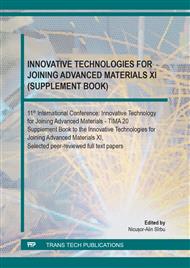p.17
p.25
p.35
p.47
p.55
p.67
p.77
p.87
p.97
Estimating the Concrete Compressive Strength by Using the Concrete Ultrasonic Pulse Velocity and Moduli of Elasticity
Abstract:
Developing a non-destructive method which delivers fast, accurate and non-invasive results regarding the concrete compressive strength, is an important issue, currently investigated by many researchers all over the world. Different methodologies, like using the simple non-destructive testing (NDT) or the fusion of different techniques approach, were taken into consideration in order to find the optimal, most suitable method. The purpose of this paper is to present a new approach in this direction. The methodology consists in predicting the concrete compressive strength through ultrasonic testing, for non-destructive determination of the dynamic and static moduli of elasticity. One important, basic assumption of the proposed methodology considers values provided by technical literature for concrete dynamic Poisson’s coefficient. The air-dry density was experimentally determined on concrete cores. The dynamic modulus of elasticity was also experimentally determined by using the ultrasonic pulse velocity (UPV) method on concrete cores. Further on, the static modulus of elasticity and the concrete compressive strength can be mathematically calculated, by using the previously mentioned parameters. The experimental procedures were performed on concrete specimens, namely concrete cores extracted from the raft foundation of a multistorey building; initially they were subjected to the specific NDT, namely ultrasonic testing, and the validation of the results and the proposed methodology derives from the destructive testing of the specimens. The destructive testing is generally recognized as the most trustable method. The precision of the proposed method, established with respect to the destructive testing, revealed a high level of confidence, exceeding 90% (as mean value). It was noticed that even the cores with compressive strength outside of mean range interval (minimum and maximum values) presented high rate of precision, not influencing the overall result. The high rate of accuracy makes this method a suitable research background for further investigations, in order to establish a reliable NDT methodology which could substitute the very invasive and less convenient, destructive method.
Info:
Periodical:
Pages:
77-86
Citation:
Online since:
June 2021
Price:
Сopyright:
© 2021 Trans Tech Publications Ltd. All Rights Reserved
Share:
Citation:


